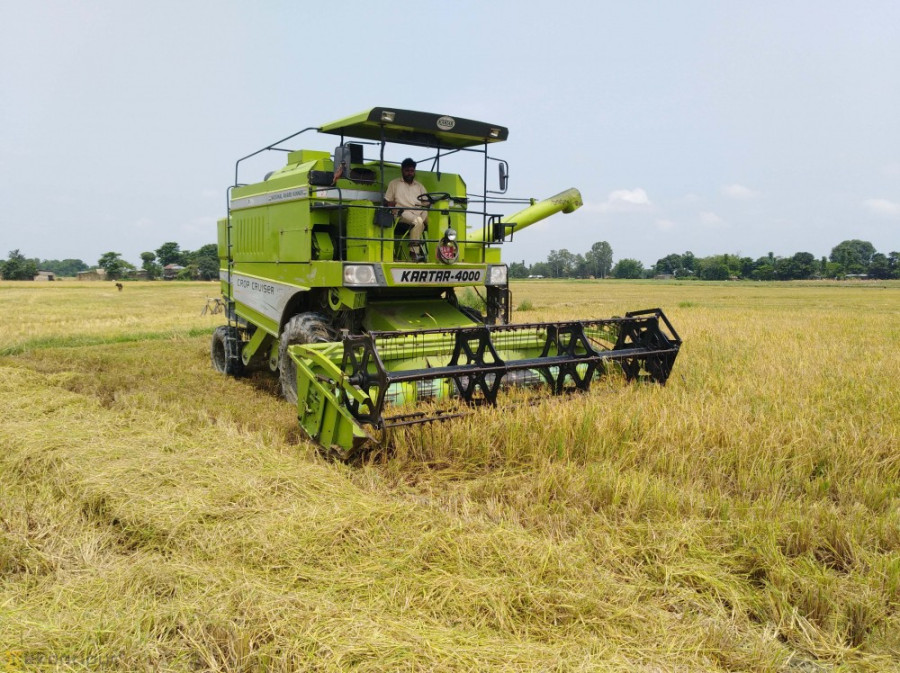Opinion
The modern farmer
Conservation agriculture results in better health, better soil and a better environment.
Nabin Bhandari
Agriculture experts globally are reluctant to recommend the conventional method of farming, where the main task is to plough the land again and again to loosen the soil before planting the seed. Experts are more focused on alternative methods of production and advise pursuing sustainable production rather than bumper harvests in one season. Sustained production is the major aim of conservation agriculture, which incorporates a number of apparently counterintuitive and often unrecognised elements that simultaneously promote soil health, productive capacity and ecosystem services.
Conventional agriculture, also known as industrial agriculture, is highly resource and energy intensive and has an adverse impact on the sustainable yield capacity
of natural land. Conservation agriculture, on the other hand, is a concept for resource-saving agricultural crop production that strives to achieve acceptable profits together with high and sustained production levels while concurrently conserving the environment, according to the Food and Agriculture Organisation. It aims to minimise soil disturbance and encourage crop rotation, and retains the soil crop residue to reduce soil and environmental degradation.
The first principle of conservational agriculture, minimum tillage and soil disturbance, protects the soil against water and wind erosion, saves fuel, labour and time, and improves infiltration and conservation of soil moisture and organic matter. In the long run, this method of agriculture has the benefit of reducing the amount of fertiliser needed per hectare of land. The second principle is permanent soil cover with crop residues and live mulches, which protects the soil from erosion by water or wind, suppresses weed germination and growth, improves recycling of nutrients, and improves organic matter accumulation and carbon sequestration.
The third principle is crop rotation and intercropping, a practice of altering different crops in the same field. Crop rotation and intercropping techniques give unique benefits to the grower. First, crops with different rooting systems utilise the soil water at different soil depths and help to increase the efficiency of water use. Second, since different crops are susceptible to different diseases and pest agents, growing such crops in rotation will reduce incidences of disease and pests at no cost. Third, crops with different rooting patterns take up nutrients at different soil depths. The addition of legumes helps to increase the nitrogen level in the soil because they are biologically nitrogen-fixing agents.
This system of agriculture is not only feasible but should be applied urgently. This farming practice has long been practiced, knowingly or unknowingly, by our ancestors and is easy, cost-effective and environment-friendly. Nepal’s growing population means more mouths to feed by utilising the limited cultivated land, but intensive farming cannot be a permanent solution. The adverse repercussions of continuous application of synthetic compounds to increase yield is irreparable.
One may argue that there are few people who can switch from conventional farming to conservation agriculture, as it takes time and money. Novices can even encounter a financial loss. Furthermore, a financial crisis can occur due to the need to buy new equipment such as zero tiller and transplanter. But meticulously analysing the direct and indirect benefits of conservation agriculture shows that the results are far better as compared to conventional farming. And, in the long run, the approach is cost-effective.
The adoption and spread of conservation agriculture requires a change in the mindset and behaviour of all stakeholders, from small farmers to top-level decision makers. For farmers, a mechanism that encourages learning and adapting to local conditions within the constraints faced by them, and a guarantee of higher production from conservation agriculture, are a prerequisite. Fully understanding the economic, social, environmental and health benefits offered by conservation agriculture is essential to convince policymakers, planners and leaders to adopt this system of farming.
With the increasing responsibility to feed the world today and in the days to come, the conservation agriculture system is the only way to fulfil this task by maintaining soil, human and environmental health—using the same amount of land that we are using today. It is high time that we designed agriculture programmes, conducted awareness programmes and implemented strategies related to agriculture which allow us to conserve the environment while reaping the benefits provided by it.
Bhandari is an agriculture extension officer at the Department of Agriculture




 13.12°C Kathmandu
13.12°C Kathmandu










